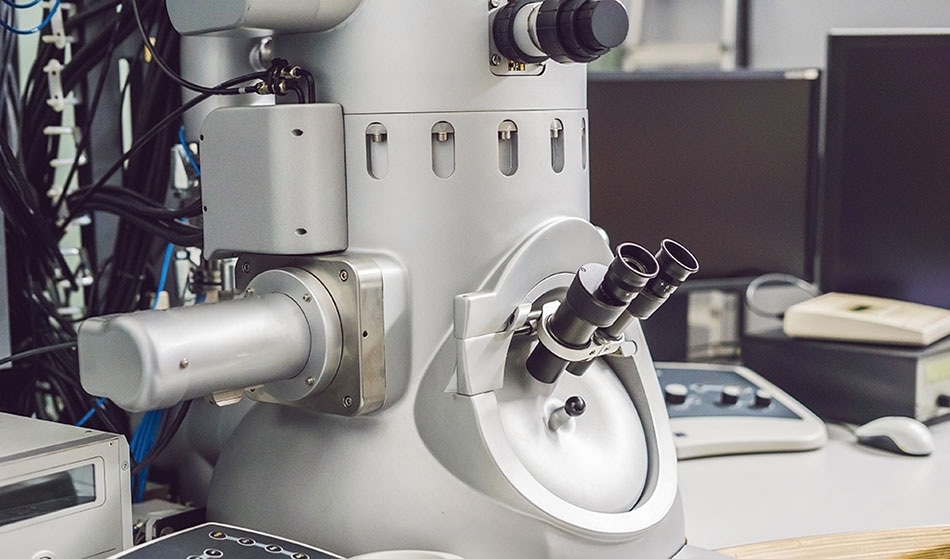Until now, achieving an atomically resolved image of monolayer organic crystals, such as the Phtalocyanines (Pc), has only been possible by using probe microscopes and a bulk material substrate base. Now a team of researchers from Vienna, Austria have determined the dynamics of these materials under a TEM instrument and have used low-dose electron microscopy to image the undamaged surface of Phtalocyanine organic crystals using a graphene substrate.
Monolayer organic crystals of Phtalocyanine and Copper-Phtalocyanine (CuPc) have gathered a lot of attention from scientists as the active material, and model system, in surface science and microscopy applications.
 Image credit: Elizaveta Galitckaia/Shutterstock
Image credit: Elizaveta Galitckaia/Shutterstock
These organic crystals are usually imaged by probe microscopy, but this normally requires the use of a bulk substrate material – where the surface is used to prepare the organic crystals. Using bulk materials makes the crystal inaccessible to (scanning) transmission electron microscopy (TEM). Additionally, TEM is challenging in itself for these measurements, because the critical electron dose of the monolayer organic crystal is orders of magnitudes lower than that of bulk crystals.
To combat this, the researchers grew and deposited CuPcCl16 onto another monolayer material – graphene. The researchers then studied these Copper-Phtalocyanine crystals as a model system to investigate the radiation damage of the organic molecules under a TEM process.
Previous efforts in this field have allowed halogenated organic crystals to have some of their radiation resistance properties to be determined using aberration corrected (scanning) TEM. These experiments even yielded some images of the molecular defects within the crystals, but these experiments have only ever looked at materials with thicknesses of several tens of nanometers. This research showcases the first attempt at producing an atomically resolved image of a monolayer CuPcCl16 crystal by using low-dose imaging combined with translational averaging.
To grow the organic crystal monolayers, the Austrian-based researchers evaporated CuPcCl16 powder (Sigma Aldrich, Phtalocyanine green) onto monolayer graphene on TEM grids (Graphene). The researchers used a homemade UHV (ultra-high vacuum) sample preparation system to carry out the deposition. The system allowed the sample to be transferred to TEM without being exposed to air and subsequent contaminants. The thickness of the films was measured using a quartz microbalance, and all electron microscopy images were taken with a Nion UltraSTEM 100 instrument, combined with an annular dark-field (ADF) detector.
This approach was able to atomically resolve the dynamics of the CuPcCl16 monolayer crystal under the electron beam. In addition, an image of the undamaged molecules was produced using low-dose electron microscopy.
The results showed the mechanisms for the dynamics and radiation damage in the 2D layer and complimented previous research into bulk crystals. However, unlike in the bulk studies, the damage mechanisms and subsequent reactions could be directly imaged.
The researchers found that the main damage mechanism was due to the instantaneous loss of chlorine atoms upon electron irradiation. Cross-linking between the damaged molecules could be observed, and this led to a stabilization of the crystal structure, and it is this that enabled the crystal to be imaged at higher electron doses.
However, the critical electron dose for these monolayer crystals was found to be much lower than their bulk counterparts. The researchers have put this down to two main reasons. The first is that the critical electron dose was defined as “the dose where the diffraction spot intensity has decayed to 1/e”. However, this definition is not sensitive to the damage of the individual molecules. Instead, it factors in the degradation of the long-range order in the crystal.
The second reason is due to the so-called “cage effect.” This effect plays a key role in the damage mechanism, and if a bond is broken by the electrons, then the subsequently created radical cannot escape the crystal. This is also more likely for larger atoms, such as chlorine. This leads to a high probability of atomic recombination.
In addition to showcasing the dynamics and radiation damage mechanisms, the ability to image the undamaged crystal structure of the monolayer will allow for the characterization of new composites that are composed of 2D materials and organic molecules.
Source:
“Insights into radiation damage from atomic resolution scanning transmission electron microscopy imaging of mono-layer CuPcCl16 films on graphene”- MittelBerger A., Scientific Reports, 2018, DOI:10.1038/s41598-018-23077-z
Disclaimer: The views expressed here are those of the author expressed in their private capacity and do not necessarily represent the views of AZoM.com Limited T/A AZoNetwork the owner and operator of this website. This disclaimer forms part of the Terms and conditions of use of this website.